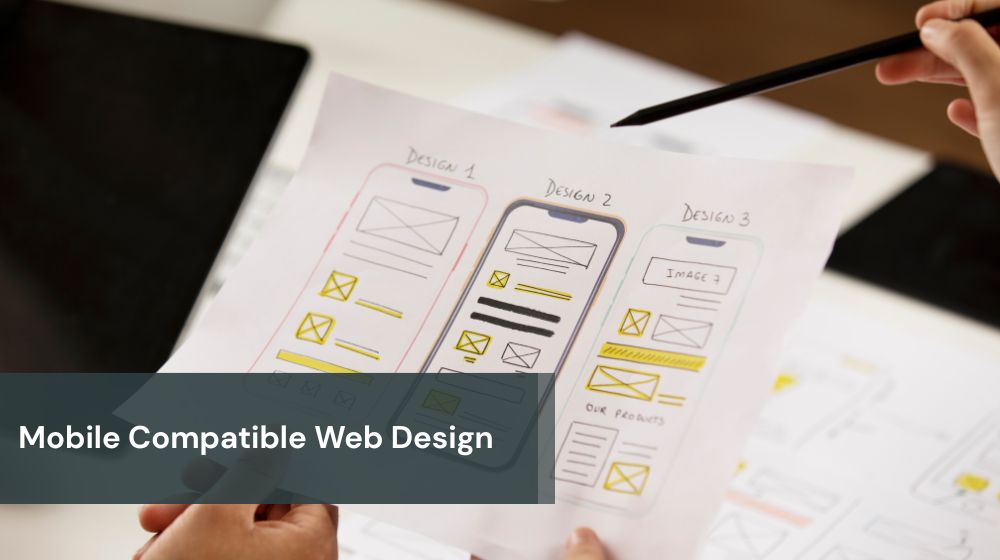Table of Contents
- Mobile-Compatible Web Design: What Is It?
- What Are the Benefits of Mobile-Compatible Web Design?
- Why Is Mobile-Compatible Web Design Important?
- How Is Mobile-Compatible Web Design Achieved?
- How Can User Experience Be Improved with Mobile-Compatible Web Design?
- What Techniques Are Used to Create Mobile-Compatible Web Design?
- What Is the Impact of Mobile-Compatible Web Design on SEO?
- How Can Site Speed Be Optimized with Mobile-Compatible Web Design?
- Why Is Mobile-Compatible Web Design Important for Businesses?
Mobile-Compatible Web Design: What Is It?
Mobile-compatible web design is an approach that ensures websites display seamlessly across various mobile devices, such as smartphones and tablets. As people increasingly use mobile devices to access the internet, it’s essential for websites to function effectively not only on desktop browsers but also on mobile platforms.
It enhances user experience and improves site accessibility. A mobile-compatible website allows users to access information quickly and easily, offering a positive experience that encourages longer engagement with the content. Mobile-compatible websites are also favored by search engines like Google, which rank them higher than non-mobile-friendly sites, boosting their visibility.
Mobile-compatible web design is typically achieved using responsive design techniques. These ensure the website automatically adapts to the screen size, delivering an optimal experience. This way, content is displayed correctly, and user interaction is streamlined across devices. It enhances user experience, improves accessibility, and aids in achieving better search engine rankings, making it a critical consideration for modern website design.
[youtube::BfcwOOR0mqA]
What Are the Benefits of Mobile-Compatible Web Design?
As Vayes Digital, we emphasize the importance of mobile-compatible web design. This approach ensures websites display seamlessly on various mobile devices, such as smartphones and tablets, and offers numerous benefits.
First, mobile-compatible web design enhances user experience. With most people accessing the internet via mobile devices, a website must be user-friendly and display correctly on these platforms. A mobile-compatible website enables users to access information quickly and easily, positively impacting their experience.
Second, it increases site accessibility. It allows users with mobile devices to access your website anytime, anywhere, expanding your reach to a broader audience of potential customers and visitors.
Third, mobile-compatible web design helps achieve better search engine rankings. Google and other search engines prioritize mobile-friendly websites, ranking them higher than non-mobile-compatible ones. This can improve your site’s visibility in organic search results.
Mobile-compatible web design enhances user experience, improves accessibility, and boosts search engine rankings. For modern website design, prioritizing mobile compatibility is essential. At Vayes Digital, we focus on delivering these benefits through mobile-compatible designs. Contact us to enhance your business’s potential and strengthen your digital presence!

Why Is Mobile-Compatible Web Design Important?
Today, internet access habits have significantly shifted. People now frequently use smartphones and tablets alongside computers to browse the web. Consequently, a website’s compatibility with mobile devices is critical for user satisfaction and overall impact.
Mobile-compatible web design ensures users can view the website seamlessly across different screen sizes. Just as content must be well-organized and accessible on desktop browsers, it should be equally functional on mobile devices. This enables users to navigate comfortably and access information quickly.
It also significantly improves user experience. Mobile users expect fast loading times, easy navigation, and readable content. A mobile-compatible website meets these needs, increasing user satisfaction and engagement time.
Search engines prioritize mobile-compatible websites. Google, for instance, ranks mobile-friendly sites higher, driving more traffic to them compared to non-compatible ones. This underscores the critical role of mobile-compatible design in SEO (Search Engine Optimization).
How Is Mobile-Compatible Web Design Achieved?
As a digital agency specializing in mobile-compatible web design, we offer solutions that ensure your website displays perfectly on smartphones, tablets, and other mobile devices. Prioritizing user experience, our mobile-compatible designs allow visitors to navigate your site effortlessly and consume content with ease.
We optimize text for screen sizes, use enlarged buttons, and create touch-friendly links to deliver an exceptional experience for mobile users. This ensures your site is favored by Google and other search engines, achieving higher rankings and reaching a wider audience.
At Vayes Digital, we enhance SEO performance, improve user experience, and strengthen your online presence with mobile-compatible web design. In today’s mobile-centric internet landscape, professional mobile-compatible design is essential, and we’re here to deliver it.
How Can User Experience Be Improved with Mobile-Compatible Web Design?
Mobile-compatible web design offers numerous advantages that significantly enhance user experience. Ensuring websites display correctly and are easy to use on mobile devices encourages users to stay longer and enjoy a more positive experience.
It provides content tailored to screen sizes, making it easier for users to access and read information on mobile devices. Text is larger and more readable, while buttons and links are designed to be touch-friendly for seamless interaction.
Mobile-compatible design improves user experience by enabling fast loading times. Mobile internet connections can be slower, so quick load times allow users to access content efficiently, enhancing their overall experience.
Navigation and interactive elements are also optimized for mobile devices. Menus, pop-ups, and forms are designed for easy access and usability on touchscreens, ensuring users feel comfortable while browsing.
Additionally, mobile-compatible design is crucial for SEO. Google and other search engines prioritize mobile-friendly sites, ranking them higher and favoring those that offer better mobile user experiences. This attracts more visitors and strengthens online presence.
Improving user experience, attracting more visitors, and boosting SEO performance are key benefits of mobile-compatible design, making it essential in today’s mobile-driven internet landscape.
What Techniques Are Used to Create Mobile-Compatible Web Design?
Mobile-compatible web design is achieved using modern technologies and design principles. Here are some key techniques used to create mobile-compatible web design:
Responsive Design: Responsive design enables a website to automatically adapt to the screen size and device, ensuring a consistent display across various platforms.
Flexible Grid Systems: Mobile-compatible designs often use flexible grid systems, which place content blocks in adaptable sizes and positions, maintaining layout consistency across different screen sizes.
Mobile-Focused Content: Mobile users typically seek quick access to information. Thus, mobile-compatible design prioritizes concise, essential content that is easily accessible and prominently displayed.
Touch-Friendly Controls: Since mobile users navigate via touchscreens, mobile-compatible designs include touch-friendly controls. Buttons, menus, and links are designed to be easily tappable with fingers.
Fast Loading Times: Mobile internet connections can be slower, so mobile-compatible design targets fast loading times. Avoiding unnecessary images and code helps increase site speed.
Mobile Testing: Continuous testing on various mobile devices and browsers ensures the website’s appearance and functionality remain consistent, providing a seamless user experience.
SEO-Friendly Design: Mobile-compatible websites are designed to align with SEO principles, incorporating factors like page speed and mobile usability to improve search engine rankings.
A combination of these techniques ensures effective mobile-compatible web design, delivering a consistent user experience and enhancing performance and usability across devices.

What Is the Impact of Mobile-Compatible Web Design on SEO?
Mobile-compatible web design has a significant impact on SEO (Search Engine Optimization). Here are its key effects on SEO:
Search Engine Rankings: Google and other search engines prioritize mobile-compatible websites, ranking them higher due to their enhanced performance and user experience on mobile devices.
User Experience: Mobile-compatible design ensures easy navigation and viewing on mobile devices, encouraging users to stay longer and view more pages, which search engines factor into rankings.
Speed and Performance: Mobile-compatible websites typically load faster and perform better. Fast loading times reduce bounce rates and are a key ranking factor for search engines.
Increased Traffic: With the rise in mobile device usage, mobile-compatible websites attract more visitors, boosting traffic, which search engines view positively when determining rankings.
External Links and Shares: Mobile-compatible websites are more shareable and accessible on mobile devices, leading to more external links and social media shares, which enhance SEO value and rankings.
The SEO impact of mobile-compatible web design lies in its ability to enhance user experience, improve performance, and attract more traffic, all of which contribute to higher search engine rankings.
How Can Site Speed Be Optimized with Mobile-Compatible Web Design?
Optimizing site speed with mobile-compatible web design is crucial for enhancing user experience and increasing conversion rates. Here are some tips to improve site speed:
Image Optimization: High-resolution images can slow down page loading. Using compression techniques to reduce file sizes helps decrease loading times without sacrificing quality.
Minifying CSS and JavaScript Files: Compressing CSS and JavaScript files reduces their size, speeding up page loading and improving user access.
Cache Utilization: Browser caching prevents repeated loading of site elements, enabling faster access for returning visitors and significantly boosting site speed.
Minimalist Design: A simple, minimalist design avoids unnecessary elements, reducing loading times and enhancing user experience compared to complex layouts.
Content Delivery Network (CDN) Usage: A CDN distributes site content across global servers, allowing faster access for users worldwide, improving speed and user experience.
Choosing a Fast and Reliable Hosting Service: The speed and reliability of your hosting service significantly affect loading times. A fast, dependable host ensures quicker page loads and better user experience.
In conclusion, optimizing site speed with mobile-compatible web design involves techniques like image optimization, file compression, caching, minimalist design, CDN usage, and selecting a reliable hosting service. These methods ensure faster loading, improve user experience, and boost conversion rates.
Why Is Mobile-Compatible Web Design Important for Businesses?
Mobile-compatible web design is a critical factor for businesses today, as mobile device usage continues to rise. Businesses must have mobile-compatible websites to reach potential customers and target audiences effectively. Here are key reasons why it’s important for businesses:
User Experience: A mobile-compatible website ensures easy access across various mobile devices, enabling seamless navigation and a positive user experience.
Search Engine Rankings: Search engines like Google prioritize mobile-compatible websites, ranking them higher and enhancing user experience, which boosts visibility.
Traffic Increase: With growing mobile usage, a mobile-compatible website expands your reach, allowing access anytime, anywhere, and growing your customer base.
Competitive Advantage: A mobile-compatible website sets you apart from competitors. Customers may avoid non-mobile-friendly sites, giving you an edge.
Brand Image and Trustworthiness: A mobile-compatible website projects a professional image, building customer trust and strengthening your brand’s reputation.
Mobile-compatible web design is vital for businesses as it enhances user experience, boosts search engine rankings, increases traffic, provides a competitive edge, and strengthens brand image. Businesses should invest in mobile-compatible websites to deliver seamless access and create a compelling user experience.


